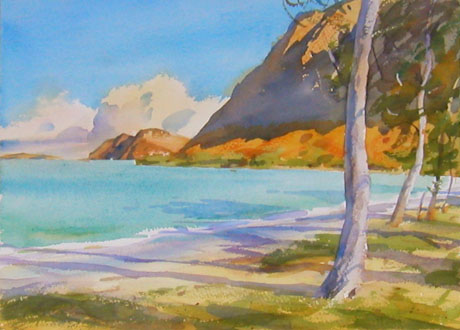 Painting “ Waimanalo Bay” in Soft Pastel
Painting “ Waimanalo Bay” in Soft Pastel
The painting itself measures 22 x 30” and was executed almost entirely out of doors over multiple sessions. This was done to capture as much of the actual visual experience as possible. While not the most convenient way to paint, I enjoy it, and it is the richest experientially and the most challenging for me. I trust that the gradual store of visual knowledge obtained this way will be of great benefit as I mature as a painter, and that it hopefully is a path to sincerity and authenticity in the final work.
This small watercolor painting was the first step toward creating the pastel that I’ll be developing here. It’s always wise to do preliminary work at a location before committing to a more involved painting. If nothing else, you save time by addressing the big questions about the suitability of the subject, as well as seeing it in varying light conditions.
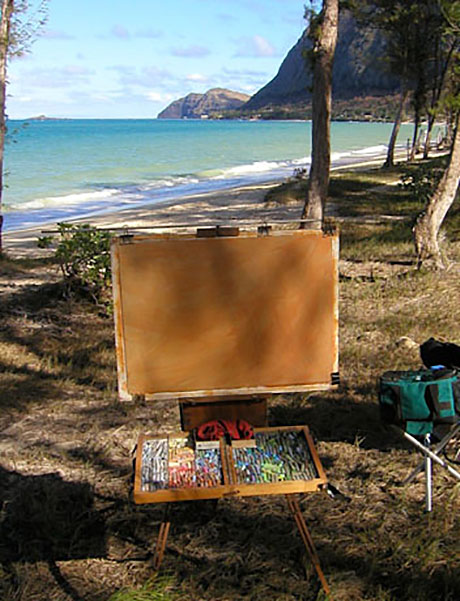 My gear includes my outdoor pastel set (an assortment of brands) in a Heilman box, a Julian full-box easel, a lightweight, homemade plywood drawing board measuring 24 x 32”, a mahlstick, chamois, cotton rag, and a pair of small boxes for creating subsets of color unique to the painting.
My gear includes my outdoor pastel set (an assortment of brands) in a Heilman box, a Julian full-box easel, a lightweight, homemade plywood drawing board measuring 24 x 32”, a mahlstick, chamois, cotton rag, and a pair of small boxes for creating subsets of color unique to the painting.
My painting surface is a sheet of Strathmore 3 ply board, primed with an acrylic gesso/pumice mixture, and washed in a warm earth tone of Raw and Burnt Sienna. This warm under painting is very helpful in relieving the iciness of the local color.
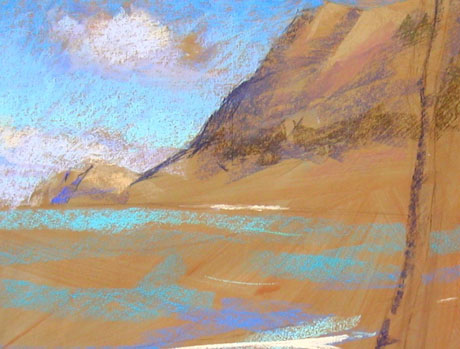 My block-in is in sepia Cont’e crayon, and it amounts to a careful searching for a slightly unusual placement of the main elements. This shouldn’t be rushed, because I will be stuck with these choices. Since I have the watercolor painting as a lead-in, I’ve already decided on some placements, but I also seek to improve upon this. There needs to be more to the painting than what a postcard offers, and so I’m intent upon exploiting textures, carefully observed middle values and tones, and a deliberately rough surface to allow for more expression. The trees are receiving a bit more lean away from the vertical than is actually present in nature, and I’m varying the proportions of some masses to improve the patterns.
My block-in is in sepia Cont’e crayon, and it amounts to a careful searching for a slightly unusual placement of the main elements. This shouldn’t be rushed, because I will be stuck with these choices. Since I have the watercolor painting as a lead-in, I’ve already decided on some placements, but I also seek to improve upon this. There needs to be more to the painting than what a postcard offers, and so I’m intent upon exploiting textures, carefully observed middle values and tones, and a deliberately rough surface to allow for more expression. The trees are receiving a bit more lean away from the vertical than is actually present in nature, and I’m varying the proportions of some masses to improve the patterns.
What is paramount in all that I’m trying to do is to capture the large impression and maintain unity of effect in the painting. That’s the effect that is drawing me to the subject in the first place; the unique combination of darks, lights, shapes and colors here at this particular time and place. This is very easy to lose in the process of developing the painting.
My initial steps are:
- Finding and placing a prominent dark and light, to establish the outer limits of the value range.
- Some sort of color “notes” of the most fleeting effects of color. These must come first because they only appear briefly. For example, the blue shadow in foreground sand and the light next to it is noted immediately because it’s very transient. The clarity of this particular day isn’t typical of this area, and I may not have this light again for days. These touches will serve as important reminders in later sessions of the larger color effect I’m pursuing, and remind me to wait for it to appear.
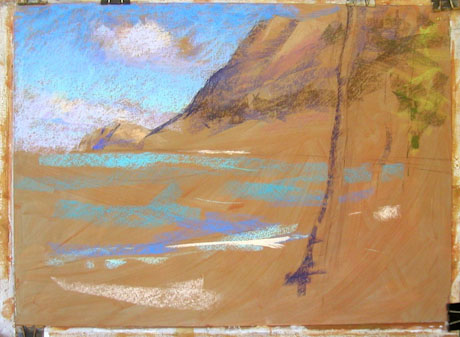
Now for the application of pastel.
Close up of the first afternoon’s work.) I always regard pastel as painting rather than drawing, and so I’m using the broad stroke of the side of the pastel as I would a large brush. I hope to keep the painting energetic and vibrant, and so I’m consciously using my strokes to establish that from the start. I intend to say as much as I can with each touch, as an economy of means. When I compare the paintings of our time to those of the artist’s I historically admire, there is an obvious negligence as to the cultivation of a beautiful “touch” in our day. I’m hoping to address this in my own work, and so I tend to delay smudging and “blending” techniques as long as I can, if I use them at all, and feel that they have a rather small place in the overall painting. Somehow, the longer I work in pastel, the more inclined I am to take this view, preferring to soften effects by using closer color and value choices rather than blending mechanically.
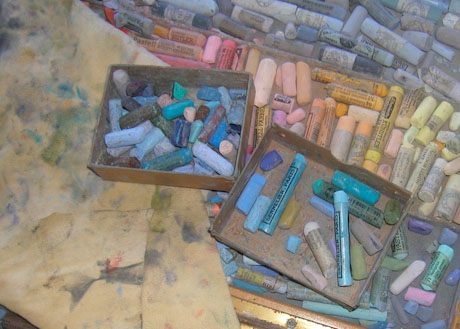
I create sub-sets of colors, notes that I see in the particular subject I’m painting, that remain in these smaller boxes until the painting is completed. As much as I try to be an orderly and systematic worker, I’m not by nature. My pastels are currently set-up largely by value rather than hue, but I’m generally too occupied and impatient (lazy) to put things back perfectly in place.
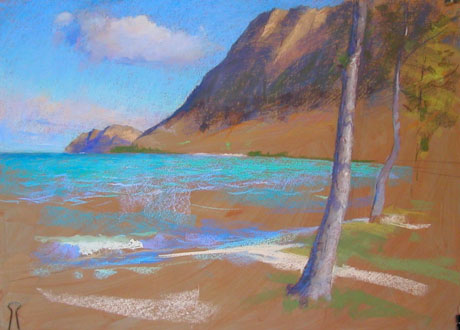
This is the second afternoon’s work, of about 90 minutes. The sky was slightly overcast, making the darkest notes lighter and the lightest notes a bit grayer. My general rule is that when the light is right, work on color, and when the light isn’t, work on shapes. So, I made progress on the shape and drawing aspects. During breaks in the clouds where the sun emerged momentarily, I would jump back into some color work. The small boxes of colors used in past sessions expedite this greatly.
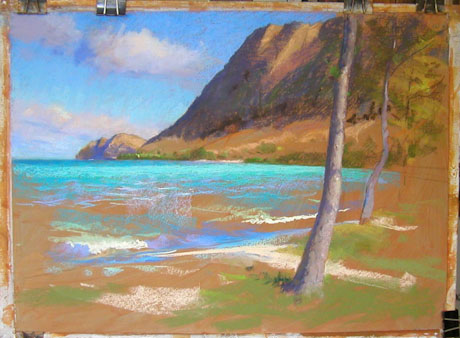
This is another afternoon’s work, several days later. The light was very clear and I was able to study and develop areas in the light as well as in the shadows. The colors in the shadows in the cliffs are intriguing, and I find them especially fun to work on. If I could somehow paint a picture with values and color as the primary vehicle, shapes used only to give them a general place to be in the composition, I’d be thrilled. That could be where I’m eventually headed, but I’m not yet prepared to totally disregard so many beautiful shapes and patterns.
I think I know just how I’d like the tree trunk to work; values and temperature shifts loosely placed, with some under painting reading through. Some of the shades of grey are beautiful, especially in the distant trunks, where they take on a bit of a pinkish-violet warmth in the ambient light. I have to wait for the light to fall, or “arrive”, in order to place these notes, and so I’m moving around the painting a lot.
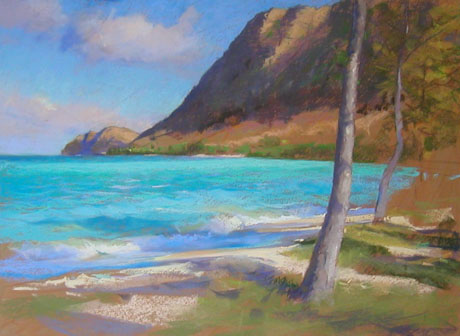 Another day with good light, and now is the moment to work on one of the most challenging areas; the water in the foreground.
Another day with good light, and now is the moment to work on one of the most challenging areas; the water in the foreground.
One has to be selective in painting this area. Too much “broken information” (tiny observations, perhaps accurate in themselves, but which result in overburdening the general effect), can accumulate while painting water that’s in motion before your eyes.
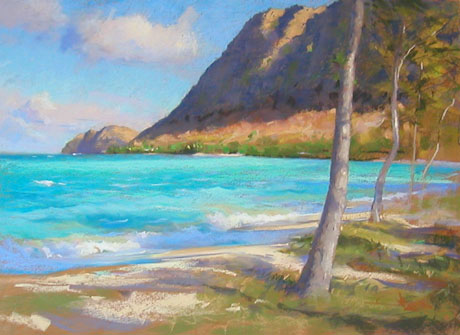
Everything is happening quickly, and the light is changing constantly as it filters through all the obstacles, so there is a need to for restraint here. Try to find the main things, keep the lights selected and to a minimum because of their power of attraction (or distraction).
A small whitecap has been added to the left hand side of the painting to give that area some more interest and balance.
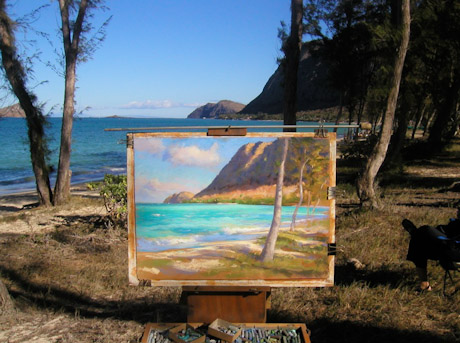
This will be my final afternoon on this painting. It’s really a round up, where I ask myself some critical questions:
Have I captured what I wanted to capture, and expressed this as well as I’m able?
Are the various areas of the painting developed appropriately to their degree of importance to the painting?
Have I gotten hung up in any areas that need simplification or unification?
Are the colors and values true to nature and expressing what I am experiencing when I’m here?
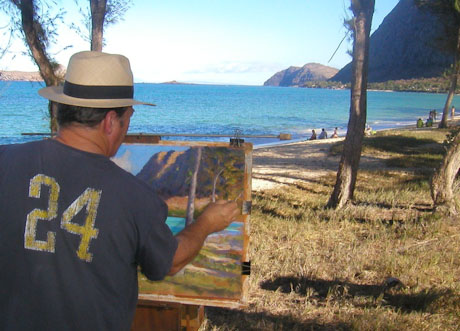
These are the questions that come to mind when I view a painting for the last time at the source of the inspiration. I hope that I’ve done something that will move a viewer as I’ve been moved. I’d hope that they might sense the distance, the scale of these mountains, and even the textures under foot (I often end up painting barefoot, by the way, but it doesn’t help the paintings).
I will take this back to the studio, put it out of sight for a while, and then bring it out and make adjustments if necessary. The frame is already under construction, and I’ll have the artwork placed under UV resistant glass.
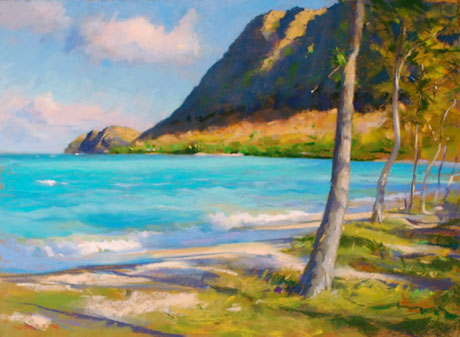
The completed painting. “Waimanalo Bay” 22″ x 30″
Note: As of this writing, this painting has been sold. I mention this because it’s an opportunity to mention the other part of the artist’s process, which is completion of the cycle of creativity by someone being moved enough by the work to want to own it.
This is never the sole reason for making a painting of course, but it also cannot be disregarded. With all of the places for money to go in this world, I’ve learned that it’s important for artist’s to remind buyers that the purchase of a painting helps make the next painting possible. I find that buyers often don’t realize the contribution and encouragement they are providing, and that they really appreciate knowing this. I also believe it’s right and perfectly appropriate to tell them.
I liken this to the building of a trans-continental railway; the purchase of a work of art is like laying track in front of the train engine, allowing it to continue it’s forward progress. No track, no train. It’s that simple.
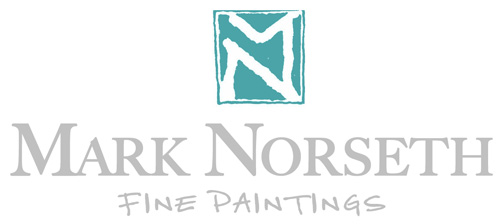

No comment yet, add your voice below!